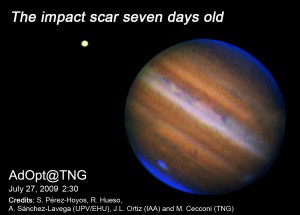Jupiter impact 2009 – follow-up observations
A first class telescope for a first class astronomical site
July 23, 2009I am back… Jupiter Impact 32 days after its discovery
August 13, 2009Hello,
I am sorry for not having written much on this blog over the last week. After we confirmed using the Keck NIRC2 image that indeed Jupiter must have been impacted, I have been very busy with discussions with my colleagues to set up a post-impact campaign. Here a few inputs.So what’s new with the observation support? Our group requested and got telescope time to observe Jupiter with the VLT Adaptive Aptics system called NACO. I spent a significant amount of time preparing the Phase 2 (a.k.a the way the observations will be colllected) and we got our first data on Monday. It was very hectic and the lack of communication with Paranal 24 h before the observations made everything complicated. I will process the data quite soon hopefully. We also got observing time on middle-class telescopes, such as the William Herschel Telescope, a 4.2m telescope and the TNG (Telescopio Nazional Galileo), a 3.5m telescope, both located in Canary Islands. The data are being taken, processed or analyzed at the time of writing.
As candy eye, I am posting here a picture taken with the TNG under moderate seeing conditions by my colleagues in Canary Island. 7 days after the impact, the southern pole scar is still visible and looks more elongated (20 deg?) than on our Keck image. It may be due to strong differential zonal wind at this latitude on Jupiter upper atmosphere. Jupiter atmosphere is modifying the shape of the scar and we hope to collect more data to be able to characterized the zonal winds.
I will keep you tuned,
Clear skies,
Franck M.




2 Comments
Damn that’s a neat picture. Most all the smart people are now saying that whatever hit Jupiter was “small”. Whatever made a hole that big was not small my friends, I’m saying at least 1 kilometer wide. Brutal stuff!
[…] up by our team using adaptive optics systems on various large telescopes including Keck-10m, TNG-3.6m, and the VLT-8m. That was a fun moment in my career which leads to a large international […]